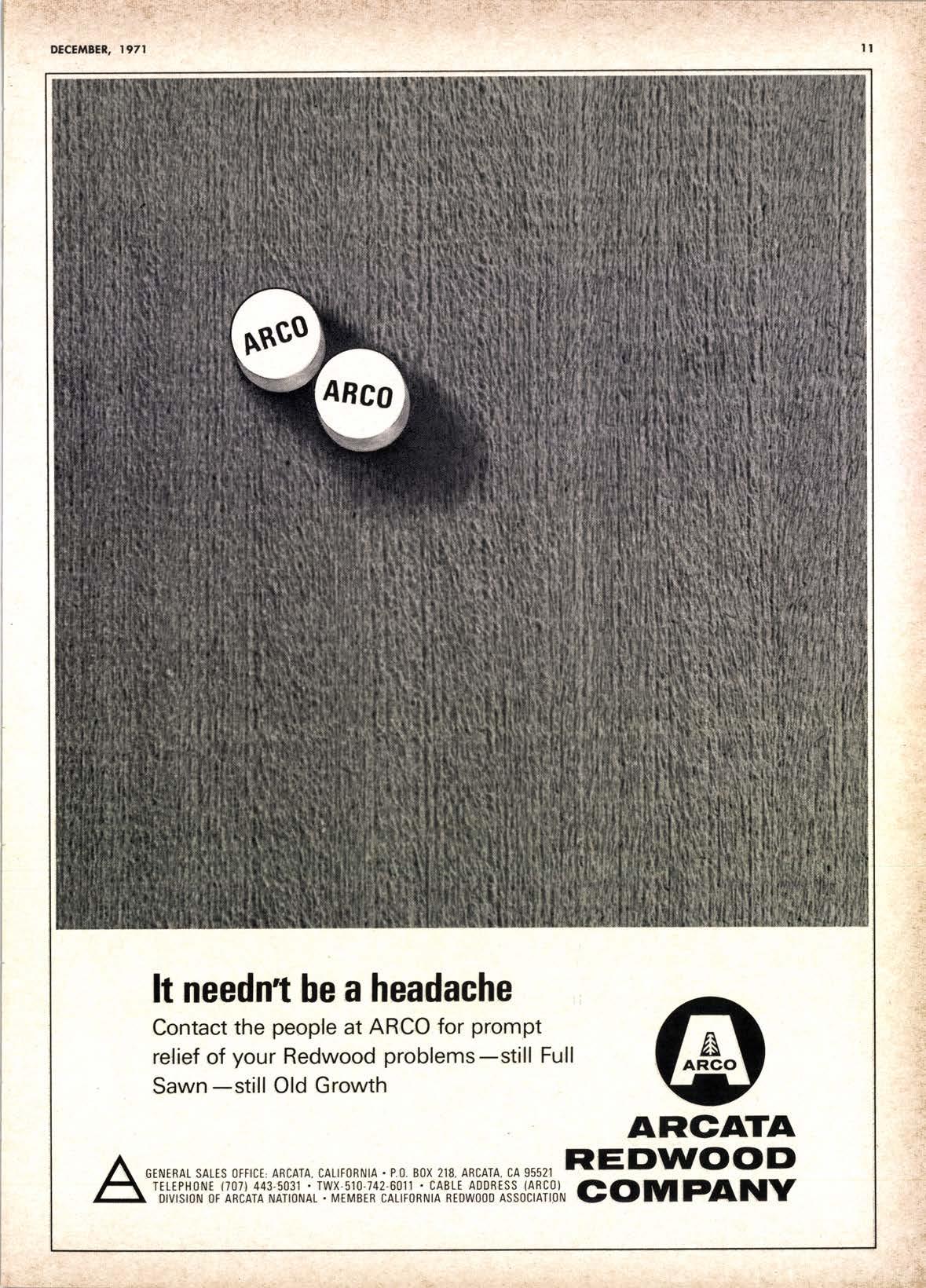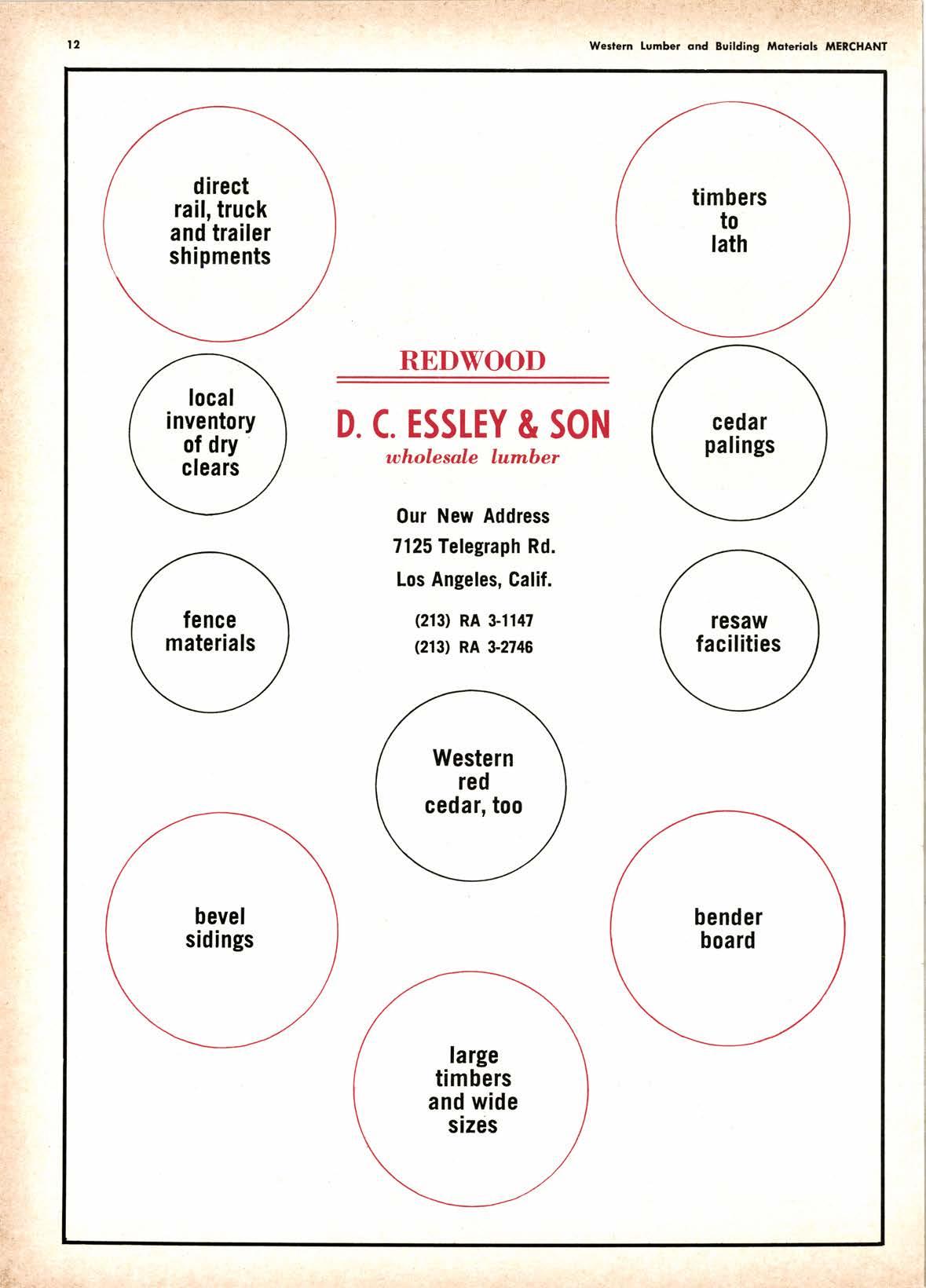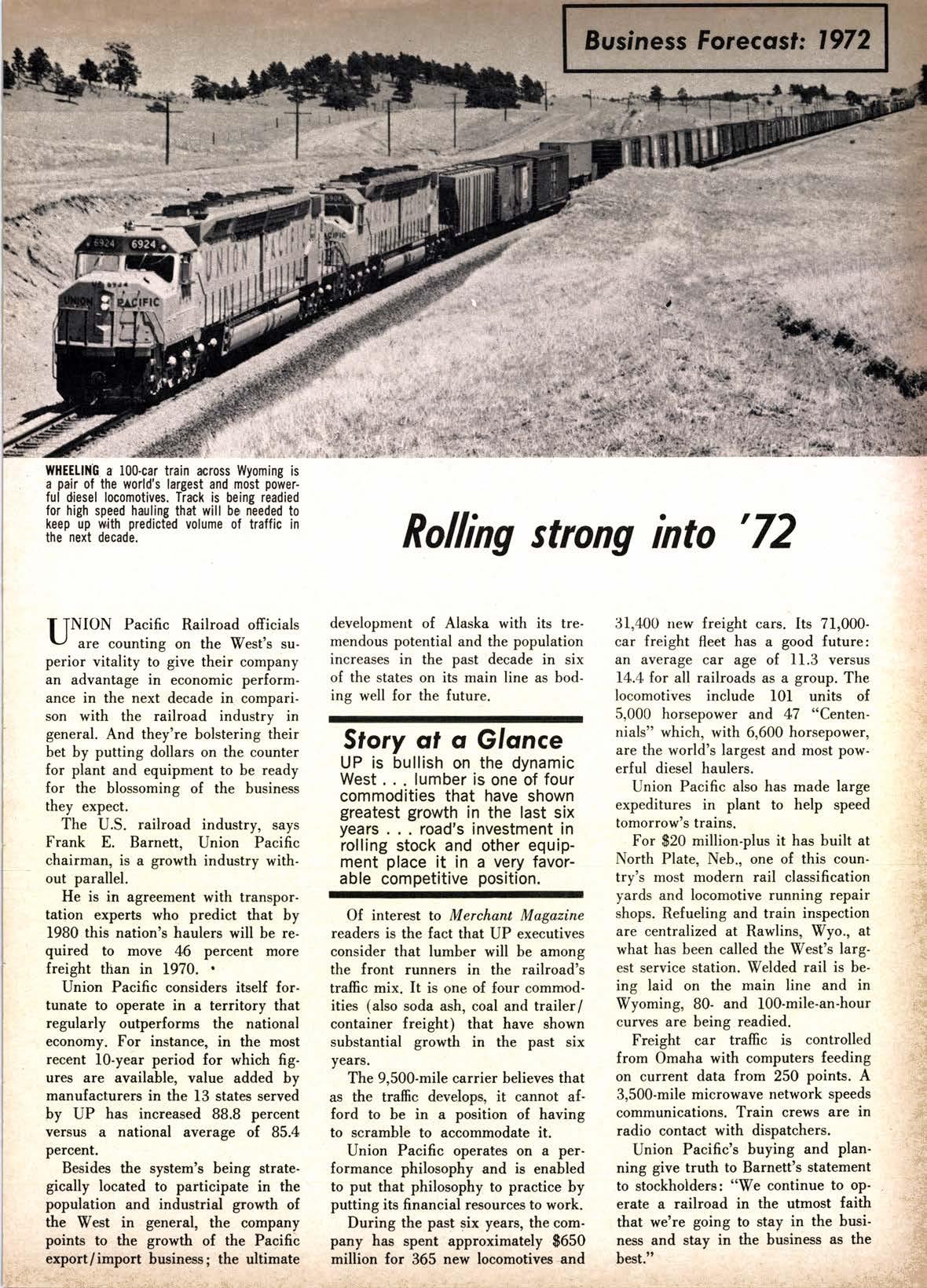
5 minute read
Possihle price hikes ai husiness gains
By Wendell B. Bornes executive vice president Western Wood Products Ass'n.
qOME concern has been expressed \J because the housing start figures for September showed a decline from August. There need be no cause for concern for two reasons: firsl, September marks the beginning of the bad weather season, and construction traditionally shows a decline at this time of year. Even with the decline, the seasonal ad. justed rate of 1,985,000 for September of this year was still well above the 1,509,000 recorded in September of last year.
Sfory dt s Glqnce
Conventional housing start increase to 2.1 million in'72 lumber consumption in '72 should be up 17,3% over the '70 figure housing start increases should continue . significant price increases next year possible.
Second,, and most important, is tied to the projection WWPA and other economic prognosticators are making for 1971. This is to be one of the best years ever for the housing market. WWPA has said that all signs point to the building oI 2.4 million housing units this year. The mix will include conventional single and multi.family units of between I.95 and 2 million units. To this should be added another 450;000 to 475,000 mobile homes.
Now, with a projection for housing starts for the year to be, at the most, 2 million, we must look at the seasonally adjusted rate which was recorded during the sunimer months. That rate has been running about 2.8 million. Therefore. unless there is a reduction in the rate of housing starts toward the end of the year, the actual figures for the year would be well above the predictions. And that simply is not in the predictions.
There is no indication, either, that there will be a slowdown in the housing boom that we have talked about for so many years and is now finally here. For 1972, we can expect the housing start figure for conventional units to rise to 2.1 million starts. This does not include some half.million mobile homes.
This year is showing quite a contrast to the period since 1968 when, mainly due to high interest rates, the annual level of housing starts has been below the 2.6 million level set by the Housing and Urban De. velopment Act a's the goal for each year of the 1970s.
However, mortgage money became available this year, and housing-start totals shot up. About two months ago, the administration put its pocketbook on the line in defense of its announced housing goals. Two billion dollars were released in special assistance funds for the purchase of unsubsidized FHA-VA single-family and multi-family mortgages. This flow of funds will continue to be made available at a ? percent ceiling rate.
In addition, figures just released by the United States Savings and Loan League show that savings growth at savings and loan associa. tions ended the third quarter on a strong note. The gain for September moved up from the high level of August and reached a record high for the ninth month of the year.
Coupled with the special assistance funds, the increased savings made even more money available for mortgages, and this availability was reflected in the increase in mortgage loans. September of this year showed an increase of. 59.2 percent in mortgage loans made compared with September of 1970. For the first nine months of the year, there was an increase ol 95.4 percent over Iast year. Mortgage lending remained at an historic high for September, with closings reaching almost $3.5 billion. And this in the face of a usual seasonal decline.
All this activity in housing con. struction means an increase in lumber used, and tl'ris is borne out by the records. Last year, this nation used 32 billion board feet of soft. wood lumber. This year it should consume an additional 4 billion board feet for an increase of about 2.5 percent.
For 1972, the demand will be 5.5 billion board feet over the 1970 figure, or an increase of 17,3 percent. Western lumber will account for about 1.4 billion board feet of the predicted 1971 increase, and about 2.5 billion board feet of the 1972 increase in lumber consumption.
If the housing start increases continueand I see no reason why they should notand dealer inventories continue to decline, and unseasonal demand late this year and early next will put pressure on supply availability. Production cer. tainly will be down due to winter operating conditions. We all know how sensitive prices are to supplydemand imbalances. All factors considered, there could be some signifi cant price increases lalsydepending upon what happens in the Presi. dent's Phase IIif unseasonal demands develop due to a combination of low retail inventories and brisk housing starts.

WHEELING a 100-car train across Wyoming is a pair of the world's largest and most powerful diesel locomotives. Track is beins readled for high speed hauling that will be nleded to keep up with predicted volume of traffic rn the next decade.
T fNION l)acific Railroad officials
U ur" countins on the Vest's su. perior vitality to give their companv an advantage in economic performance in tlrc nert dccade in comnarison with tlre railroad inrlustrv irr general. And they're bolstering their bet by putting dollars on the counter for plant and equipnrent to be ready for the blossorning of the busine,.s they expect.
The U.S. railroad industry, says Frank E. Barnett. flnion Pacific chairman, is a growth industry without parallel.
He is in agrccment with transportation experts who predict that by 1980 this nation's haulers will be required to move 4,6 percent more frcight than in 1970.
Union Pacific considers itself fortunate to operate in a territory that regularly outperforms the national economy. For instance, in the most reccnt lO-year period for which figures are available, value added by manufacturers in the 13 states served by LP has increased 88.8 percent versus a national average of 85.,1 percent.
Besides the system's being strategically located to participate in the population and industrial growth of the West in general, the company points to the growth of the Pacific export/import business; the ultimate
Rolling strong into '72
developruent of Alaska with its trernt,ntlous potcntial and the population incrcases in the pa,.t decade in sir o{ the statcs on its rnain line as boding well for the futurc.
Story dt d Glqnce
UP is bullish on the dynamic West , . lumber is one of four commodities that have shown greatest growth in the last six years . road's investment in rolling stock and other equipment place it in a very favorable competitive position,
Of interest to Xferchant llaguzine readers is the fact that UP executives consider that lunrber will he anrons tlre frorrt runners in tlrc railroad'-" tra{Ec mix. It is one of four commoclities (also soda ash, coal arrd trailcr/ container freight) that have shown substantial growth in the past six years.

The 9,500-mile carrier believes that as the traffir: develops. it cannot a{ford to be in a position of having to scramble to accommodate it.
Union Pacific operates on a per' formance philosophy and is enabled to put that philosophy to practice by putting its financial resources to work.
During the past six years, the company has spent approximately $650 million for 365 new locomotives and
31"100 new freight cars. lts 71,000car freight fleet has a good future: an avcrage car age of I 1.ll versu-s I:1,. l. for all railroads as a group. The loconrotives include i01 units of 5.000 horscporver and 47 "L-entennials" rvhich. rvith 6.600 horsepower, are thc rvorld's large-st and most porverful diesel haulers.
I nion Pacific also has marle large expeditures in plant to help speed tomorrow's trains.
['or $20 million-plus it has built at \orth Plate. ,\_-cb.. one of this country's rnost modern rail classification yards and loconrotive running repair shops. Ilefueling and train inspection are centralized at liawlins. Wyo., at what has lreen callcd the \\'c-.t's large.st service station. Welded rail is bcing laid on the nrain line antl in Wyoming. 80. and l0O-mile-an-hour curves are being rcadied.
Freieht car trallic is controllt'd frorn Omaha with computers {eeding on current data from 250 points. A 3.500-mile microwave network speeds comrrrunicalions. Train crews are in radio contact with dispatchers.
Union Pacific's buying and planning give truth to Barnett's statement to stockhoiders: "\\re continue to operate a railroad in the utmost faith that we're going to stay in the business and stay in the business as the best."









